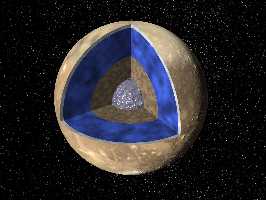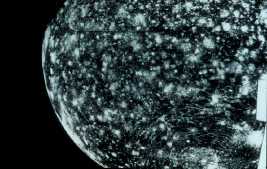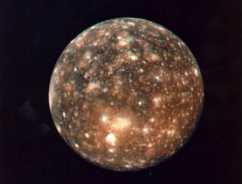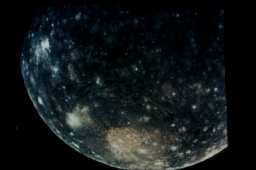This drawing shows the evolution of Callisto.
Click on image for full size
NASA
Evolution of Callisto
Measurements by the Galileo spacecraft have been shown that Callisto is the same inside from the center to the surface. This means that Callisto does not have a core at the center.
This means that, unlike Ganymede, Callisto probably never warmed up enough while it was forming to allow for the materials inside to separate.
The lack of warmth prevented any movements of the crust which would have changed the appearance of the surface over time.
You might also be interested in:

Differentiation is a scientific term which really means "to separate". In their earliest history, elements which made the planets would part into separate regions, if the planet were warm enough. This
...more
The surface of Callisto is deeply marked with craters. Craters are the little white marks in the picture. It looks like it might be the most heavily cratered body in the whole solar system. And some of
...more
Amalthea was discovered by E Barnard in 1872. Of the 17 moons it is the 3rd closest to Jupiter. Amalthea is about the size of a county or small state. Amalthea is named after the goat in Greek mythology
...more
Callisto was first discovered by Galileo in 1610. It is the 2nd largest moon in the solar system, and is larger than the Earth's moon. It is about as big as the distance across the United States. Callisto
...more
Measurements by the Galileo spacecraft have been shown that Callisto is the same inside from the center to the surface. This means that Callisto does not have a core at the center. This means that, unlike
...more
Many different types of surface are shown in this picture. In the front is a huge crater, which goes for a long way over the surface. This crater could be compared to that of Mimas. They both show that
...more
Europa was first discovered by Galileo in 1610, making it one of the Galilean Satellites. It is Jupiter's 4th largest moon, 670,900 km ( miles) from Jupiter. Europa's diameter is about half the distance
...more













